

Skylar Tibbits: The emergence of "4D printing" New Zealand Man is 3D-Printing a Fully-Functional 1961 Aston Martin Replica. New Zealander Ivan Sentch is 3D printing an entire 1961 Aston Martin DB4 replica!

Using a CAD rendering from TurboSquid, which he modified to suit his design goals, Sentch has so far produced 2,500 fiberglass molds and four four-inch sections that he has mounted on a wooden frame and glued into place. He spent about $2,000 on plastics for the 3D printing, and now plans to build a mold for a fiberglass exterior shell. There are only 1,200 existing models of the 1961 Aston Martin DB4 in the world, each costing between several hundred thousand to $1 million on the auction circuit. Because of its limited availability, software engineers can’t get a hold of detailed designs, which eventually forced Sentch to crib a CAD rendering from TurboSquid to get his car built.
It may not look like it, but Sentch has been using the 3D printing technology only since last December. So far he’s spent about $2,000 on the 3D printing material and still plans to create the exterior shell out of fiberglass. Cubify Wants To Domesticate The 3-D Printer. Amongst other surprises at CES this year, young 3-D printing company Cubify took home the Best Emerging Tech award for their second-generation printer, the CubeX.
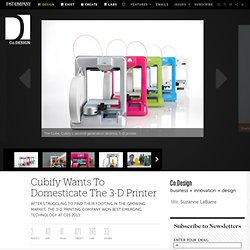
Launched only a year after their first machine, the CubeX and its little brother, the Cube, sell at a significantly lower cost than competitors and are geared toward kids, artists, and other consumers who might not have a ton of experience with the technology. They’re your mother’s 3-D printer--and I mean that in a very good way. The irony behind their friendly, primary-colored marketing materials is that Cubify is actually the consumer brand of the first 3-D printing company ever: 3D Systems, a 30-year-old company founded by inventor Chuck Hull.
Hull patented the first 3-D printer (he called it a stereolithography apparatus) in 1983. He was responsible for everything from developing the .STL file format to engineering the chemical makeup of the material. Check out the Cube, which starts at $1,299, here. Researchers claim 3-D printers pose 'health risk' CHICAGO — Three-dimensional printers using the fused deposition molding (FDM) process could pose a health risk to operators, according to researchers from the Illinois Institute of Technology in the U.S. and the National Institute of Applied Sciences in Lyon, France.
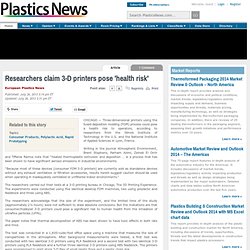
Writing in the journal Atmospheric Environment, Brent Stephens, Parham Azimi, Zeineb El Orch and Tiffanie Ramos note that “heated thermoplastic extrusion and deposition … is a process that has been shown to have significant aerosol emissions in industrial environments. “Because most of these devices [consumer FDM 3-D printers] are currently sold as standalone devices without any exhaust ventilation or filtration accessories, results herein suggest caution should be used when operating in inadequately ventilated or unfiltered indoor environments.”
Express Yourself in 3D. 3D printing with metal: The final frontier of additive manufacturing. The holidays are a great time to sit back, relax, and watch the world happen around you.
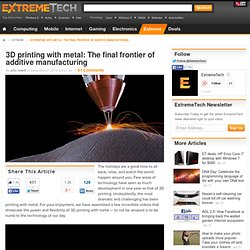
Few areas of technology have seen as much development in one year as that of 3D printing. Undoubtedly, the most dramatic and challenging has been printing with metal. For your enjoyment, we have assembled a few incredible videos that showcase the power and flexibility of 3D printing with metal — to not be amazed is to be numb to the technology of our day. The first attempts to print with metal can be traced back to the 1880s when the first welders used carbon electrode arcs to fuse two pieces of metal. It was later found that if a third sacrificial stick of material was used a metal bead could be laid down.
The real breakthrough that has enabled 3D printing for the masses has been the laser. NASA recently used a technique called selective metal melting (SLM) with great success to build rocket motor components out of steel. 'Drone It Yourself' Lets You Create a Drone from Any Object. Have you ever wished for a flying book?
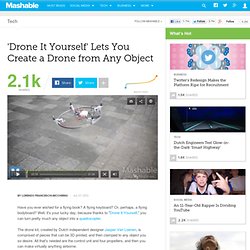
A flying keyboard? Or, perhaps, a flying bodyboard? Well, it's your lucky day, because thanks to "Drone It Yourself," you can turn pretty much any object into a quadrocopter. The drone kit, created by Dutch independent designer Jasper Van Loenen, is comprised of pieces that can be 3D printed, and then clamped to any object you so desire. All that's needed are the control unit and four propellers, and then you can make virtually anything airborne. On his website, Van Loenen points out that the parts can be custom-designed, and that other DIY enthusiasts can modify them to make new add-ons for the quadrocopter drone. To find out more, check out the video, above. Technology - 3D printing powered by thought.
Imagine if you could print objects just by thinking about them.
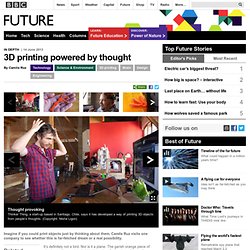
Camila Ruz visits one company to see whether this is far-fetched dream or a real possibility. It’s definitely not a bird. Nor is it a plane. The garish orange piece of plastic, small enough to hold in the palm of a hand, could pass for a missing limb of a toy tyrannosaurus. It may not look all that impressive, but it’s notable for two reasons. This milestone was reached with little fanfare last month at the Santiago MakerSpace, a technology and design studio in the Chilean capital. Engineers and designers have been using 3D printers for more than two decades. “What is the point of these printers if my son cannot design his own toy?” That’s where Emotional Evolutionary Design (EED), the software that allows Thinker Thing to interpret its users’ thoughts, comes in.